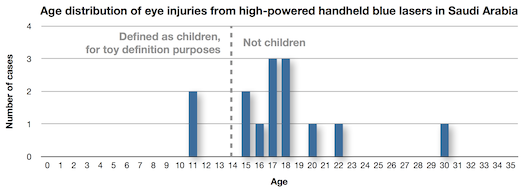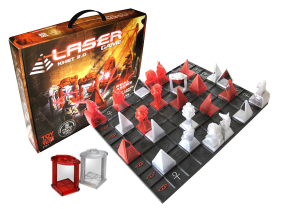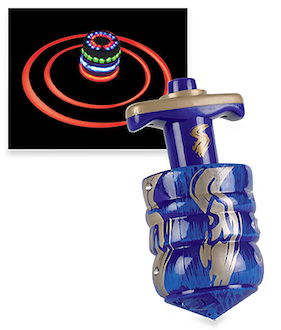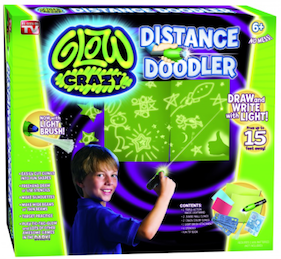Home
A comprehensive resource for safe and responsible laser use

Special Report: Are laser toys an actual hazard?
A note from the website’s author: The discussion below represents my personal thoughts and research; this is why it is in the “Perspectives & Opinions” section.
This page is the first in a series which includes:
Google search for laser toy — How many laser toys are really out there?
Comments on specific studies or press releases:
American Academy of Ophthalmology - Laser toy studies
American Academy of Ophthalmology - Handheld blue laser toys
American Academy of Ophthalmology - Laser toy eye injuries
U.S. FDA - 2013 laser toy press release
Comments submitted by LaserPointerSafety.com on the FDA’s 2013 laser toy proposal
Laser toy updates
Introduction
In December 2013, our monitoring of Google news alerts turned up at least 25 news stories about the dangers of laser-containing toys. At LaserPointerSafety.com, we were unaware of such toys being currently on the market, at least in the U.S. We therefore did some research.
Our conclusion is that there may be one potentially hazardous and possibly non-compliant laser-containing toy being sold in the U.S. Other than that, the potential threat is mischaracterized and essentially non-existent:
- Specifically, a claim by the American Academy of Ophthalmology appears to be false, that high-powered blue handheld laser devices “are often marketed as toys”. Our online search turned up no high-powered handheld lasers of any color being marketed as toys.
- A separate claim, also by the AAO, that toys that contain laser devices “commonly cause eye injuries” also appears false.
- An August 2013 Food and Drug Administration press release, warning about laser toys, gives a number of misleading impressions, such as a false inference that a certain spinning top laser toy could cause eye injuries.
- And finally: a search of ten years of U.S. emergency room records found no record of any eye injury from any toy containing a laser.
If you misuse a laser pointer, does it turn into a “toy”?
Why are there so many false statements about laser toys?
The main reason seems to be that the AAO, FDA and others such as medical journal authors are confused about general-purpose lasers being misused, versus lasers that are specifically built into or marketed as toys.
When a laser is misused by pointing it at another person, the AAO and FDA appear to be making an unsupported assumption that the person was “playing” with the laser as if it were a toy. They believe that simply pointing an ordinary laser pointer at a person somehow transforms the device into a “toy”.
If this was true, then a common stick would be “marketed as a toy” or would be a “stick-containing toy” if it is poked at someone. Or to give another example, if a child used a screwdriver to poke at a playmate, then the screwdriver becomes a “toy.” Of course, this is not the case. The stick remains a stick and the screwdriver remains a screwdriver, even if misused during children’s’ play.
This muddied thinking then leads to article headlines such as the AAO’s Dec. 5 2013 press release, “High-Powered Handheld Blue Laser Toys Can Cause Serious Injuries.” The AAO quoted doctors in Saudi Arabia as saying that these high-powered blue lasers were “often marketed as toys.” Both the headline and the claim are not true. This is discussed in depth here; below is a summary of the key points:
- The high-powered handheld blue lasers were not marketed as toys, at least not online, as far as we have been able to tell.
- The type of laser in question is sold through the Internet at around USD $300, which is substantially more expensive than most children’s toys.
- The Saudi doctors who made the claim have not yet provided any evidence for their statement about the marketing of these lasers. In fact, the Saudi doctors apparently did not do any market study or analysis to determine whether or how “often” these lasers were marketed as toys, if ever.
- The Saudi doctors provided no evidence that the lasers were being used in a toy-like way. In each of the the six in-depth cases discussed, one person pointed a high-powered laser at another. But there is no specific indication of “playing” or toy-like behavior.
- Of the 14 reported Saudi eye injuries, only two were to persons defined as “children” — under the age of 14. The other twelve persons ranged from 15 to 30 years of age. Such “non-children” would have been exempt from any laser toy regulations which were proposed by FDA in August 2013.

In short, there were no “toys” in the study quoted by the AAO. The AAO took an unsupported claim of Saudi doctors, about marketing status of lasers in that country, and without further checking made this the basis of their Dec. 5 headline and story intended for U.S. media.
Few laser toys, no laser toy injuries
Now, as our name indicates, LaserPointerSafety.com fully supports safe laser use. We agree that lasers are NOT toys and should not be used unsupervised by children.
Our position, however, is that press releases such as the AAO and the FDA’s are — at best — overblown exaggerations and at worst are inadequately researched or are deliberately misleading. This “crying wolf” syndrome weakens the fight against actual, real-world laser misuse.
- We have not found any websites or brochures that advertise a general-purpose laser as a “toy” for children. (Just to be clear, there are many laser “toys” for pets, and there are many toys with the word “laser” or “lazer” in them that turn out to contain LED lights. These of course are not the children’s laser toys claimed by AAO and FDA to be causing injuries. Much more on this topic is here.)
- We have not found high-powered lasers, of any color, that are “often marketed as toys.”
- We have found a literal handful of products designed as toys (for children) that emit laser beams. Only one of these might be an eye hazard; we are not yet sure if the beam is from a laser or an LED light.
- We have not found any reported injures, anywhere in the world, from laser-emitting toys.
Now, we do not have unlimited resources. It may be that somewhere there are a few websites that call laser pointers “toys.” It may be that somewhere there is a toy that emits an unsafe laser beam. Perhaps somewhere a child’s retina was injured by a laser-emitting toy. But even if such cases are found, the important point is that they are exceedingly rare.
Real lasers are hazardous enough, without making up products and fake injuries
At LaserPointerSafety.com, we fully support cautioning the general public about the hazards of misusing general-purpose lasers. We support telling parents to keep general-purpose lasers away from children. We also support cautioning parents that there may possibly be a few toys that emit laser beams, and to avoid any such toys that do not have federal laser safety labels or that appear to allow beams to be freely aimed at other persons.
But we are surprised that the American Academy of Ophthalmology would not vet a scientific paper in its own journal, Ophthalmology, which contains false claims. We are disappointed that AAO put out in December 2013 two press releases with false and misleading statements.
Similarly, the FDA put out its own press release in August 2013 which misleadingly conflates general-purpose lasers, laser toys and laser injuries. (It is ironic that while the FDA’s release specifically cautions against aiming at drivers, it does not even mention the number one potential consumer laser safety hazard: widespread aiming at pilots. It completely ignores this major concern, which as of August 2013 was happening 10 times a night in the U.S.; as of 2017 it is up to 20 times a night.)
Questions to ask about claims of “laser toys” or laser toy injuries
In conclusion, if you read in the popular press or in scientific journals about claimed hazards from laser-containing toys, or injuries from such alleged toys, you should investigate further:
- What type of laser device is being discussed? Is it a “laser toy” which is specifically marketed to children? Or is the issue the safety of general-purpose lasers such as pointers which may be misused by children?
- Does the source have any documentation that a laser was being misused during play as a toy (e.g., the beam was being misused as a fake “sword” or “lightsaber”) as opposed to a child simply pointing it at himself/herself or another child?
- Does the source have any documentation that the device was sold or marketed as a toy (a product for children under 14)?
- Does the source have credible medical documentation of any claimed injuries and how that particular laser could have caused it? For example, we sometimes see reports of visible lasers causing corneal injuries, even though visible light passes through the transparent cornea. (it is absorbed by the opaque retina, which is the part of the eye that would be damaged by excess laser light).
If you do see such claims, feel free to contact us with a link or scan of the laser toy hazard claim. We will analyze it and let you know when you really should worry, and when you are a victim of muddy or misleading thinking.
Postscript
It goes without saying that the non-existent laser toy eye injuries are in contrast to actual eye hazards from real toys. For example, the Consumer Product Safety Commission estimates that in 2012, there were 2,513 injuries to U.S. children’s eyes from gas, air or spring-operated guns (e.g, airsoft, BBs).
In contrast, CPSC had only one incident in its 2012 NEISS database (sample size too small to estimate national levels) involving laser light in a person 14 or under. This was a 10-year-old playing with a red key chain pointer who shined the light into his eyes and had eye irritation. Note that this was NOT a laser-containing toy — just a laser pointer.
And looking at ten years of data, CPSC had no incidents involving laser-containing toys, in the years 2003-2012, out of 52,827 reported emergency room visits by children 0-14 due to injury by toys (code 1300 through 1399). More on the CPSC study is here.
Detailed analysis of laser toys and their hazards
WHAT IS A LASER TOY?
The webpage you are reading was created because of the many December 2013 news stories warning consumers about the availability and hazards of laser toys. These stories were triggered by two press releases from the American Academy of Ophthalmology.
Based on these alerts, the first question we had is “What is AAO warning against? What is a laser toy?”
After a detailed Google search of laser toy products, we found only three types of products currently available online that have accessible laser beams and that are marketed to children as toys:
- An award-winning game called “Khet 2.0” and a similar game called Laser Maze. They use Class 2 lasers, appear to be safe for ages 8-up, and appear to have the required FDA certification as a laser product.

- A top or dreidel which emits two beams onto the floor only while spinning. This appears to be safe since the lasers cannot be triggered unless the top is spinning fast. The one we examined did not appear to have required FDA certification, and thus may not be properly labeled for sale. While this is of concern and is a reason not to purchase the toy, the lack of certification does not mean that the toy’s use of lasers is intrinsically unsafe.

- A light-emitting pen, the Glow Crazy Distance Doodler. This appears to use a violet laser that is almost 4 times the IEC limit for its class. If it really is a laser -- we have not yet conclusively determined this -- then the toy would be unsafe for children and would also be improperly labeled under FDA regulations.

In other words, we found one possibly unsafe laser toy in our search. This may or may not contain a laser; we haven’t yet determined for sure.
Unlike the AAO’s assertion, we did not find any high-powered handheld lasers marketed as toys, either with this search or with other related Google searches.
Also, we did not find any laser-emitting swords or any toy guns with actual laser (not LED) sights. Both had been previously described by U.K. or U.S. safety regulators, but we did not see any for sale online.
IS A LASER POINTER A “TOY”?
A number of sources, including some medical journals, call general-purpose laser pointers “toys.” We disagree.
A “toy,” according to a June 2013 FDA proposal, is a product that is manufactured, designed, intended or promoted for use by children under 14 years of age. Under the FDA’s own proposed definition, a general-purpose laser pointer would not be a toy, as long as it is not manufactured, designed, intended or promoted as a toy.
This corresponds with common sense. Other long, cylindrical tools such as flashlights and screwdrivers that are sold as tools do not become “toys” merely because a child starts playing with them.
In the same way, if a laser pointer is misused by a child, this does not turn it into a toy. Yes, parents should be warned not to let children play unsupervised with standard general-purpose laser pointers. But warning parents against laser toys in general does a disservice to those toys which comply with laser laws or otherwise appear to pose no additional laser hazard.
ADDITIONAL IN-DEPTH ANALYSIS OF AAO AND FDA CLAIMS
The two key sources of the December 2013 alerts, widely distributed by various news sources, are two press releases from the American Academy of Ophthalmology:
- American Academy of Ophthalmology Warns Holiday Shoppers about Toys that Cause Eye Injuries 12/03/2013
Each of these press releases is discussed in more depth here and here. In addition, we discuss an August 2013 FDA press release, “Laser Toys: Not Always Child’s Play,” on this page.
A FINAL REQUEST FOR ACCURACY
In our view, the AAO and FDA would be more effective and accurate if they focused on educating consumers about the hazards of misusing general-purpose laser pointers, and handheld lasers. These actually have caused some eye injuries in children, teens and adults. There are legitimate concerns over public access to high-powered Class 3B and 4 lasers, and to children and teenagers misusing lasers of all Classes.
In fact, this entire LaserPointerSafety.com website is an attempt to accurately inform the public about the real hazards of consumer lasers.
But issuing inaccurate warnings about laser-containing toys, when very few such toys exist or are for sale, and only one appears to be potentially unsafe, is a waste of time and effort. And falsely claiming that such toys are commonly causing eye injuries, is focusing on a non-issue. It may even cause persons to not buy the award-winning Khet 2.0 and Laser Maze toys, which do appear to be safe and to comply with all FDA requirements.
The FDA particularly should be more careful and accurate, so they do not intentionally or inadvertently describe safe toys as unsafe, and they should not conflate laser pointer injuries with (non-existent) laser toy injuries.